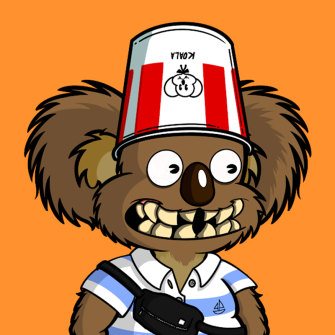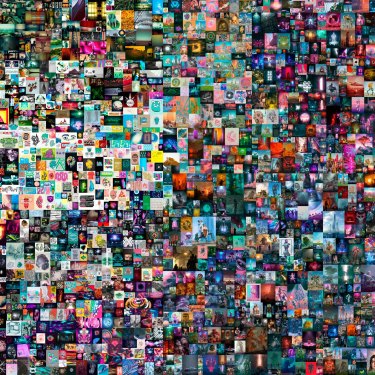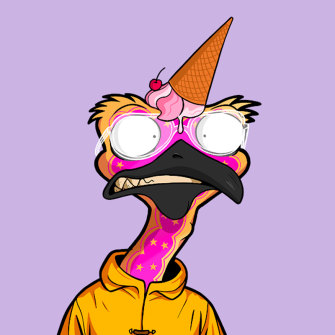One of the rarest available non-fungible tokens, or NFTs, is a small, pixelated image of a bearded man wearing dark sunglasses and a top hat and smoking a cigarette. By some estimations, it’s worth anywhere between $500,000 and $100 million.
Its owner, a Brisbane man called Daniel, is a prolific NFT collector and trader who boasts an extensive collection of digital art which, as well as the aforementioned pixelated facade from the CryptoPunk collection, includes abstract pieces, some colourful lions and apes and a version of Da Vinci’s Mona Lisa with billionaire Elon Musk’s face on it.
This sort of eclectic selection is common in the nascent NFT market, which has boomed during the pandemic alongside the cryptocurrency platforms that they rely on to function, as millions of young, usually male, investors have poured money into this new crypto-adjacent asset class in the hope of making a motza.

An example of a CryptoPunk NFT.Credit:Provided for use by owner
NFTs’ popularity has gained the attention of institutions such as auction house Sotheby’s, which sold $US100 million ($A140 million) of the digital tokens last year. Justin Bieber, Jimmy Fallon and Gwyneth Paltrow are all proud NFT owners. And it’s not just art: an image of a New York Times column, a screenshot of Twitter founder Jack Dorsey’s first tweet, a digital version of singer Shawn Mendes’ vest (which the owner can put on and wear while playing a particular online game) – all have been “minted” as NFTs and sold for thousands.
Meanwhile, new examples of NFTs’ uses are slowly emerging, including to buy digital real estate, trade video games collectibles and properly remunerate musicians.
But what exactly are NFTs? And why are they worth so much?
What’s an NFT?
A non-fungible item is, basically, unique. Your house key, your cat, your child’s drawing displayed proudly on the fridge are non-fungible – non-interchangeable for other items. A fungible item, on the other hand, is something such as a dollar, which can be replaced with another different dollar and still be worth the same, and serve the same purpose.
So, that’s the “NF” bit, but how are they tokens?
Loading
NFTs stem from the world of cryptocurrencies where digital assets such as Bitcoin and Ethereum can be bought and sold like stocks. These assets are based on blockchain technology, a decentralised, distributed network that tracks all transactions made by users on a public and immutable ledger. Cryptocurrencies have surged in both price and popularity recently.
In this context, token really means “blockchain-enabled”. It’s referring to a crypto-asset that leverages an existing blockchain to add all sorts of functionality or qualities, to it, such as higher speeds, greater security or, in this case, non-fungibility.
For the most part, NFTs leverage the Ethereum network. Ethereum, which is the world’s second-largest cryptocurrency, has the function of allowing users to program their transactions using computer code. Say, for example, you were sending money through the Ethereum network, and you wanted to make it so a person would receive their payment only once a certain amount of time has passed, or other conditions were met. This could be programmed into your transaction.
These lines of code are known as smart contracts, a set of rules that dictate how NFTs function, including providing their namesake non-fungibility and proof of ownership, and managing the transferability of the asset. The most commonly used contract that writes these rules is known as ERC-721, which includes a unique ID within the contract that cannot change and is written permanently into the blockchain.
This means that when buying an NFT, a token with a unique ID is transferred to your digital wallet (more on them later). That token proves that your NFT is original and non-fungible, and its presence in your wallet – which only you control and own the password to – is proof that you own it.
So with this in mind, an NFT is a one-of-a-kind (non-fungible) digital asset that leverages the blockchain (token) so it can be governed by a set of rules.
There are many concepts here that most of us don’t use in everyday life (yet) such as smart contracts, blockchains, tokens and so on, but the idea becomes a bit more digestible when you compare NFTs to anything collectible, like stamps, coins, or trading cards, which are often image-based, scarce or restricted in their numbers, can be worth hundreds of thousands of dollars, and are non-fungible.
NFTs in their current form are in many ways digital collectibles, albeit more technical and traceable than your grandfather’s teaspoon collection.
Where do NFTs come from?
NFT owner Rhys Dale says the collectible nature of NFTs is what drew him to the assets in the first place. “I’ve been a collector the majority of my life, from being a kid through school getting chip packets that have Tazos in them to Dragon Ball Z, Pokémon and Yu-Gi-Oh! cards,” he says. “My whole life, I’ve loved collecting.
“At first, I didn’t really understand NFTs, but then I started to wrap my head around it after doing some research. And it was so exciting as a collector and being able to see this whole new world of endless possibilities that you can create and collect. It was pretty wild.”
Dale and Nat Riley and Thomas Smith are the brains behind a selection of Australian-themed NFTs named Drop Bears and Bush Chooks, depicting a collection of koalas and emus in hoodies, Hawaiian shirts and Bunnings aprons.

An NFT from the Drop Bear/Bush Chook collection.Credit:Courtesy Drop Bears
The trio’s Drop Bears project has a maximum supply – or limited run, in non-digital art speak – of 10,000 NFTs, all of which have been “minted”. Minting is the point at which a digital file is registered on the blockchain so becomes a token – using the aforementioned Ethereum smart contracts to write the rules of the token’s non-fungibility. Early last year, when the NFT craze was at its peak, new collections would “mint out” (or sell out) within hours.
Once purchased, NFTs are transferred to the digital wallets of the buyer, with the creators (or artists) receiving a small cut. For example, the cost to mint a Drop Bear when the project launched last August was 0.06 in Ethereum, at the time worth around $280 (one single Ether was worth $4440). At 10,000 minted, the three founders made around $2.8 million (a portion of which they donated to koala conservation charities).
Each transaction also incurs fees for using the Ethereum network, known as “gas”, in much the way you (or a vendor) might pay a charge when using a tap-and-go service to buy your coffee.
However, real money starts to flow once NFTs hit the secondary market, as once a project is minted out, the only way to get your hands on one is by buying it from someone else, at times for seemingly exorbitant prices.
Hang on, what are they buying exactly?
Here’s where things get a bit murky. While an NFT is often an image, video or song, storing that much data on the blockchain can be costly and would likely slow the network significantly. Instead, NFT smart contracts include a URL that points to your asset – meaning the token itself is actually just a link to your image.
However, the smart contract does more than just link to an image. As we mentioned earlier, it also proves your ownership of that particular asset, a bit like a certificate of authenticity, or the deed to your house. So, you own not just the link, or URL, but also the image it links to, which you’re free to print out and put on your wall or on a T-shirt.
Loading
But ownership is all the contract proves, so while you have the right to display and use the NFT you’ve just purchased, the contract does not transfer copyright, nor any rights to adapt or reproduce the image. It also, crucially, does not give you the right to sue for copyright infringement if someone uses your NFT without permission, a fact that has led many NFT detractors to rightly point out that they can freely download that same image you just paid $400,000 for.
While this is the default position, it is not true for all NFT sales, however, with some marketplaces and collections specifying that purchasing the NFT also transfers the copyright for it, or grants the buyer certain rights to use or adapt an image.
And many NFTs are sold with royalties attached, meaning that the original artist will get a percentage of the sale, sometimes even when the work is sold in the secondary market.
If NFTs can be sold for thousands with royalties attached, including on resales, they’re great for artists, right?
That depends on who you ask. The art world has viewed NFTs with healthy doses of scepticism and trepidation, with the prevailing concerns being that they are a money grab with no real value for artists. And artists have found their artwork being sold by others as NFTs for thousands of dollars, with limited recourse available.
Dr Vanessa Bartlett, an academic and artist with a focus on ethics in digital art, says many artists are dubious about the value of NFTs. In fact, she believes they herald a regression in the art world to pre-internet and photography days, where art such as sculptures and paintings was largely singular, uncopiable and original.
A copy of an NFT titled Afterburn by XCOPY.
“[The internet] was this free space where you could share your work, and it fundamentally changed the relationship between artists and their audiences,” she says. “What’s happened with NFTs … is that we’ve come back to this: ‘OK, how do we make an image a rare, commodified thing?’
“From my perspective, that sort of undermines a lot of what is interesting about the internet in that it can be this quite open, networked space potentially where you can share things freely with audiences.”
She also points to questions of quality – of the “art” doing what it’s supposed to. “Art is about telling stories and about critically interrogating things. I’m not sure that every NFT that I’ve seen does that in the most interesting way.”
Bartlett can see the value in NFTs for artists looking to monetise their digital work, but notes that still requires a significant amount of luck in being promoted by the platforms and gaining notoriety in the NFT community.
Eventually, however, she believes that there will be a space for NFTs in the art world in some form or another. Some artists are employing the technology in thought-provoking ways, she notes, such as artist collective Terra0, which recently sold an NFT image of a forest programmed to “burn” (meaning, remove itself from circulation) once global average annual temperatures rise above 2 degrees.

Beeple’s artwork Everydays: the First 5000 Days sold at auction for $US69 million in 2021.
Why are NFTs worth so much?
Digital artist Beeple, an American otherwise known as Mike Winkelmann, created a digital artwork every day for 5000 days that he collaged and minted as an NFT (pictured above). It was auctioned at Christie’s for $US69 million last March. In June, a rare CryptoPunk wearing a medical mask sold for $US11.8 million in a Sotheby’s auction. And Sir Tim Berners-Lee, the creator of the internet, auctioned off an NFT of the internet’s source code, netting $US5.4 million for charity.
But while a lot of media attention tends to be drawn towards the biggest and most flashy NFT sales, most NFTs are not worth a lot. In fact, few sell for more than a couple hundred dollars.
For example, the lowest price you could currently purchase a Drop Bear on the secondary market is $70 dollars or 0.02 Ether, forming a project’s “floor price”. These floor prices can vary drastically, with one of the most popular collections, a series of apathetic-looking primates known as the Bored Ape Yacht Club, boasting a floor price of 100 Ether, currently worth around $350,000. The floor price for a CryptoPunk pixelated persona is similarly high, at around 80 Ether ($285,000).
To discern exactly why these digital images are worth so much is a difficult endeavour. Enthusiasts argue they are comparable to traditional art, which is sold for thousands of dollars at art fairs and in auction houses across the globe every week; indeed, that they’re like any rare collectible that can command sums that are gobsmacking to those unfamiliar with the esoteric quirks of the market. These enthusiasts believe NFTs’ scarcity and non-fungibility – along with blockchain-backed proof of ownership (a watertight form of provenance) – give them a valuable edge over other forms of digital art such as digital prints (print-outs of a digital image), where buyers can’t claim ownership of a unique piece.
Loading
Additionally, owning certain NFTs can grant access to exclusive events or special invite-only online chat rooms, akin in a sense to an exclusive virtual country club or door list at your local nightclub. Popular US music festival Coachella recently sold 10 NFTs granting the owner lifetime access to the festival.
While these factors certainly contribute to the value of NFT projects, a significant portion of NFTs’ allure is good old-fashioned gambling. Investors buy NFTs in the hope their price will increase so they can sell them for a profit, as with any other investment. This leads to numerous collections launched as spin-offs of other, more successful collections including Mutant Ape Yacht Club, Desperate ApeWives and the Robo Ape Yacht Club. Potential investors use social media platforms such as Discord and Twitter to promote and hunt down new NFT projects they hope will blow up or to discuss the prospects of the projects they’re already invested in.
Yet as with any emerging market, the value of NFTs must be taken with a grain of salt, or perhaps a handful. This is compounded by ownership being anonymous; there have been cases of NFT owners selling an asset to themselves via a separate anonymous account, giving the impression the image is worth a certain amount in the hopes other investors will latch on and hike the price of the rest of the collection.
Do environmental concerns about Bitcoin apply to NFTs?
The Ethereum network, which the majority of NFT transactions are processed on, consumes the same amount of power as the entire Netherlands each year. The network is powered by vast warehouses of computers crunching equations and chewing through electricity as they go. While there is some debate as to how much NFTs increase emissions, the bottom line is if you’re looking to decrease your carbon footprint, buying and selling those fancy apes won’t help.
Still, while the total energy consumption of the Ethereum network is significant, the amount that NFT transactions contribute is quite small. Remember, people do other things on Ethereum that consume electricity, such as buy and sell the Ether cryptocurrency. Additionally, NFT transactions are often bundled with other, different transactions, leading advocates to argue that NFTs do not actually increase the energy drain of the network by that much.

AN NFT from the Drop Bear/Bush Chook collection.Credit:Courtesy Drop Bears
On the other hand, if NFTs continue to gain popularity, that could, in turn, increase the value of the Ethereum network and increase the rewards for miners, who are responsible for crunching the complex equations that keep Ethereum’s blockchain running. If rewards for doing this increase, the miners may then be inspired to purchase more mining equipment (computers), upping the network’s total emissions, and so on. (Here’s an explainer on what mining has to do with crypto.)
And Ethereum’s developers are working on a new system to process network transactions, drastically reducing carbon emissions, which is slated to roll out this year. Meanwhile, other networks, such as Solana, and Ethereum derivatives such as Polygon or Australian-made Immutable X, are far less carbon-intensive, providing a solid alternative for environmentally conscious NFT hunters.
Crypto can be risky – are NFTs the same?
Yes. As in the crypto world, if you’re not careful with managing your NFTs you could find yourself empty-handed. If you’re interested in getting involved in the NFT world, it’s recommended you become familiar first with the ins and outs of buying cryptocurrency, as you’ll likely need to purchase your chosen artwork using Ethereum, Solana or another popular crypto.
Once you’ve got your hands on some crypto coins, you’ll need to set up an account with Metamask, a browser extension and mobile app that allows you to interact with the Ethereum blockchain. You’ll then need to send the ether you’ve purchased to your Metamask wallet, making sure you have enough to buy whatever NFT you’ve got your eye on.
To avoid potential scams, it’s best to stick to major NFT marketplaces. These operate a bit like eBay, allowing people to buy, sell and make offers for whatever NFT they want. Numerous are available, with some of the most popular being OpenSea, Rarible, and Nifty Gateway. The usual pitfalls of sending and receiving cryptocurrency transactions still apply, and you’ll want to make sure the digital wallet holding your NFT is well-secured.
Once you own your chosen piece, the key things to watch out for are phishing scams or fraudulent buyers, especially if the NFT you’ve bought is worth some serious dough.
Finally, as with all investments, be prepared for your NFT to be rendered worthless. This can be due to a lack of interest or investors in a project, or you could fall victim to what’s known as a “rug pull”. This is where creators of an NFT project or collection swiftly disappear after taking investors’ money, cashing out their gains and, more often than not, causing the value of the NFTs to plummet.
Plasma Globe from the Rarible collection, 2017, created by jjjjjohn.
So, where else are NFTs going to crop up?
At its core, NFT technology is a way to prove ownership of digital assets, in a transparent and trackable way, an application that theoretically could be used across a range of industries such as fashion, events and ticketing, music and advertising.
For example, Facebook’s planned digital-only virtual metaverse could be a perfect environment for NFTs, allowing people’s digital personas to purchase unique digital goods and prove their ownership via the blockchain. These same digital avatars could purchase tickets to virtual events, which could also be registered as NFTs.
There might be a place for NFTs in the music world, too. Dr Guy Morrow, a senior lecturer in arts and cultural management at the University of Melbourne, is bullish about the potential for NFTs in the music industry, something he believes could solve the issues surrounding the remuneration of artists and the ownership of original recordings. For example, an artist could sell their songs or albums as NFTs and receive far more royalties than the meagre cuts offered by streaming giants such as Spotify.
Loading
“My crystal-ball-gazing statement would be that NFTs could lead to a profoundly egalitarian system because it’s open-source software and accessible by theoretically anyone,” he says. “It would then lead to systems where you can automate trust and have smart contracts that realise some of the problems in remunerating artists.”
One of the main angles being explored for NFTs other than digital art is in the world of video games, where in-game collectibles are common but rarely have any value outside the game’s ecosystem. Right now, a character outfit in the massively popular online video game League of Legends cannot be resold or moved from the account it was purchased on. Through the use of NFTs, gamers could, theoretically, port a “skin” or rare piece of equipment from one game to another. They could also buy and sell them on secondary markets, allowing them to convert their in-game exploits into cold, hard cash.
This might sound incredibly marginal, but gamers around the world spent $US34 billion on microtransactions for props and costumes in their favourite games last year.
Thomas Smith, another of the Drop Bears founders, says the potential for NFTs in gaming is what drew him to the space.
“I’ve seen big-name games where you’d pay for skins, and you’d pay for the weapons and earn all these things, but you didn’t actually own them,” he says. “So what really attracted me [to NFTs] is the gaming aspect of the blockchain where you actually owned what you have in the game.” This means the skin or in-game item you acquire would be linked to your personal crypto-wallet, rather than tied to your game account.
However, not all are so enthusiastic about the prospect of in-game NFTs. Recently, the developer of the popular STALKER video game series, GSC Game World, backflipped on its decision to implement NFTs in the game after fierce public outcry as passionate gamers rejected the perceived money grab. Similarly, triple-A game developer Ubisoft was hit with backlash after unveiling its Quartz NFT platform.
As time goes on, it’s likely this scrutiny will continue, as many argue that NFTs (in their current form) offer little advantage to those not already deeply invested in the crypto sphere.
A sharp influx of celebrities entering the space, buying NFTs or endorsing various projects has also made some watchers dubious, further pushing the narrative that these projects are focused on hype and capital gains rather than advancing a possibly innovative piece of technology.
Still, not all celebrities are sanguine about NFTs. Big-name rapper Kanye West recently implored people, “Do not ask me to do a f–king NFT.”
“My focus is on building real products in the real world, real food, real clothes, real shelter,” he said via his Instagram account.
“Ask me later.”

No Comments Yet